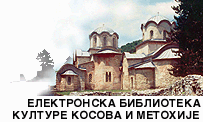

  |
| Projekat Rastko Gračanica - Peć: Istorija: Old Serbia and Albanians |
|
Dr. Aleksandar Palavestra The Iron Age princely tomb Pećka Banja in Metohija
The territory of Kosovo and Metohija, which is currently the target of NATO air strikes, was from the earliest prehistoric times the part of the dominant cultural trends of Europe and the Balkans. For thousands of years this area has saw the development of rich Neolithic agricultural civilizations, such as Starčevo and Vinča cultures. It was also where hill forts and villages of Eneolithic cattle breeders and early metallurgists were built, and where rich trade links were developed with Greek - Mycenaean towns , as well as broader Mediterranean region, in the Bronze and Iron age. In this territory Romans and Byzantines built roads, sumptuous homes, and urban centers, and in the medieval Serbian state the area was flourished with cities, fortresses, monasteries, mines and merchant centers, some of which, like Novo Brdo, bursting with the cacophony of European languages.
Another proof of the rich cultural heritage of the Kosovo-Metohija was presented at the exposition "The Archaeological Treasures of Kosovo and Metohija from the Neolithic to the Early Middle Ages" in the Gallery of the Serbian Academy of Sciences and Arts, which had to be closed because of the NATO air strikes. The Iron Age princely tomb of Pećka Banja in Metohija offer yet another evidence that this area was integrated in Europe as early as prehistoric times. The princely tombs of the central Balkans are extremely opulent graves under large mounds, rich in luxurious offerings of indigenous and foreign origin: gold, silver and amber, as well as symbols of power and prestige. Chronologically they are determined into the second half of the sixth century and the first decades of the fifth century BC. The large mounds, noticeable and distinguished at great distance, were undoubtedly clear and intelligible symbols of power of the local chiefs. It is not probable that this kind of symbolical occupation of a certain space was merely an expression of an individual's riches and vanity; it seems more likely that there was a certain specific meaning ascribed to it, explicit to the entire community. In their characteristics, the princely tombs of the central Balkan region relate to the same cultural and anthropological model as the princely tombs of west central Europe. Rich objects for daily use, gold jewelry and amber, luxurious equipment, and wagons all testify to the particular prominence and typological relationship of the princely tombs of the central Balkans and central Europe. The very character of imported goods found in the princely tombs in west central Europe and in the central Balkans points to a certain cultural similarity. The princely tombs in the central Balkans as well as in west central Europe, as representative examples of a rising culture, have served as a basis for a large number of research papers which consider the social structure and community organization in that part of Europe in the Iron Age. Such analysis has been facilitated by the detailed excavation of princely tombs in west central Europe such as Vix, Hochdorf, Grächwil, Grafenbühl, Römerhügel, Klein Aspergle, Hochmichele and others, but also of the settlements which were obviously associated with the tombs, above all Heuneburg, as well as Mont Lassois, Châtillon-sur-Glâne, and some others. In the central Balkans Pilatovići near Užice, Atenica near Čačak, Petrova crkva near Novi Pazar and Pećka Banja in Metohija may be considered as the clearest representatives of the princely tombs judging by the tomb construction and grave goods. Pećka Banja is in Metohija, on the north fringe of the Beli Drim valley. During some construction works, under a mound the remnants of two graves were registered. Under the mound the central grave construction was preserved, but the grave goods were displaced at the time when the excavation begun, so the precise relations and grave assemblages cannot be determined. The grave construction was founded by stone slabs and built in stone, in an irregular rectangle about 2 meters long. On grounds of the registered offerings, two grave assemblages are defined: a male and a female burial, though no trace neither of cremation, nor of inhumation were registered. The pottery was registered out of the graves. In the male burial, there was silver jewellery (ring of Mramorac-type, double saltaleon with a loop), three bronze helmets of the Graeco-Illyrian type, necklace of amorphous amber beads, glass beads and snail shells, three bronze fibulae, twelve large bronze buttons, four of them dressed in silver foil, and iron spears. In the female grave, a set of silver jewellery for a very gracile adult or a young girl was found, consisting of a pair of bracelets of the Mramorac-type, a pair of fibulae with rectangular plate, a pair of bracelets with snake heads, a ring, omega-pins and saltaleons, along with some Scythian arrowheads and a large amount of amber, amorphous as well as shaped. Among the finds nor associated with either grave is a bronze ornament with a palmette, probably a part of horse gear. A separate group consists of pottery - imported Greek black-figure ones (an olpe, two larger skyphoi and a smaller one), as well as numerous locally manufactured vessels. The finds from Pećka Banja are dated into the end of the VI and the beginning of the V centuries BC. The archeological findings from Pećka Banja, among the numerous other cultural monuments, show that this area has been the part of Europe for thousands of years.
|
//Kosovo.com / Projekat Rastko / Projekat Rastko Gračanica - Peć //
[ Promena pisma | Pretraživanje | Mapa projekta | Kontakt | Pomoć ]